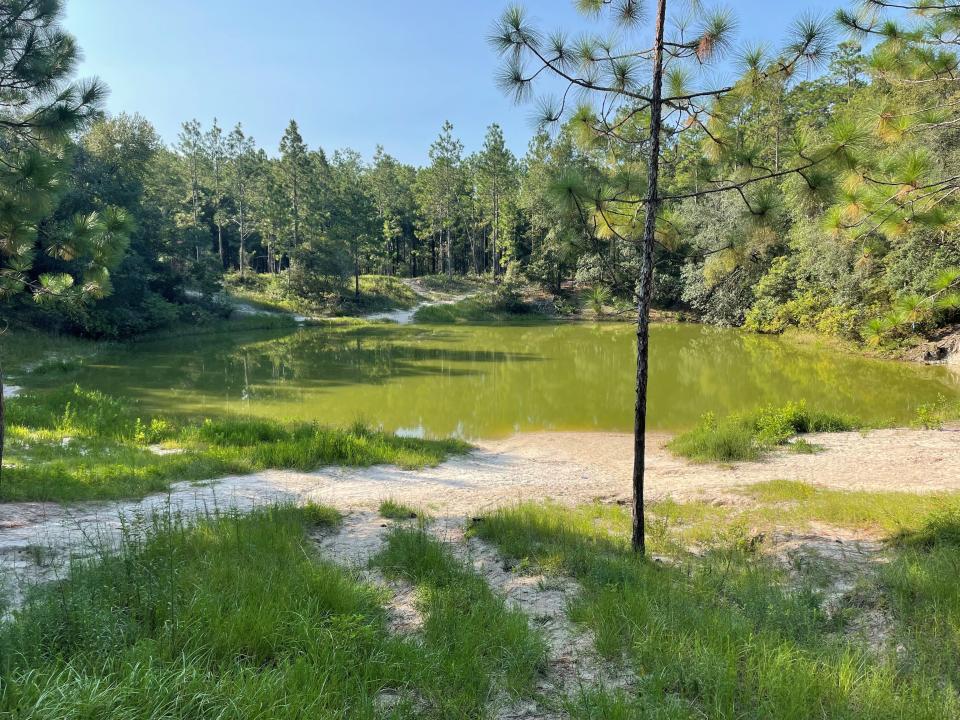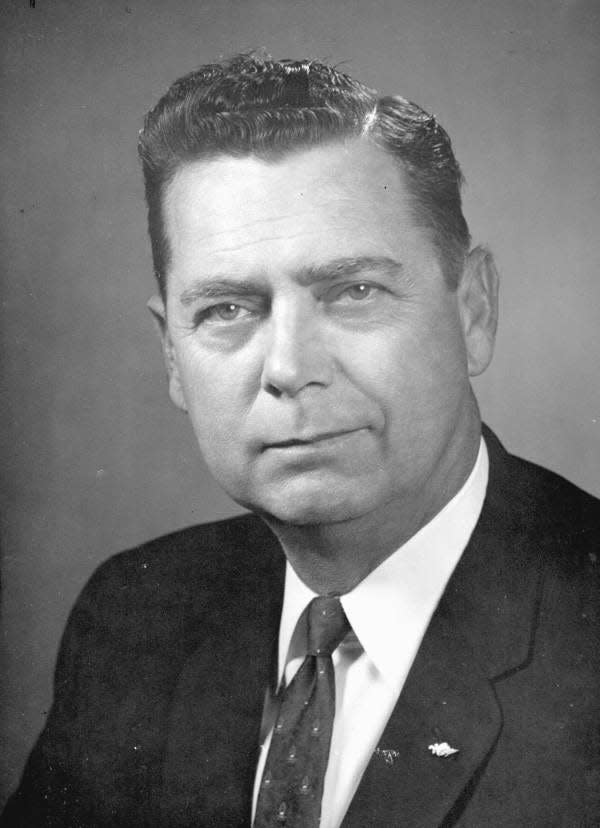The Blue Sink Murders: The strange story of Robert Scott Sanders | Tallahassee History
- Oops!Something went wrong.Please try again later.
On the morning of Oct. 18, 1967, Tallahassee awoke to the news of a second multiple slaying just four days less than a year from the last multiple killings. This marked the beginning of a topsy-turvy ride through the criminal and civil processes for the next nine years.
During the night of Oct. 17, 1967, two young women were found bludgeoned and one shot at Blue Sink, a small lake located in the Apalachicola National Forest south of Tallahassee.
A well-known popular spot for swimming during the day, it was also known as a Lover’s Lane at night. At the time, Tallahasseeans were still reeling from the tragic, unsolved Sims family murders that occurred on Oct. 22, 1966. Three members of the Sims family had been brutally murdered in their home in Northwest Tallahassee. Initial thoughts were that the same person was responsible for both crimes.

The crime
The first notice of the murders came at 1 a.m. on Oct. 18 when an anonymous man, who remains unidentified 56 years later, called the Tallahassee Police Department and reported to Lieutenant George Granger that he had seen two bodies at Blue Sink. He refused to identify himself saying that he shouldn’t have been there. In a strange coincidence, Lt. Granger later learned that one of the victims was his cousin.
Leon County deputy sheriffs rushed to the area and found the two bodies who were later identified as Elizabeth Ann Wood and Kaye Granger. Both were 17-year-old seniors at Florida High School in Tallahassee whose families lived close to each other in a quiet neighborhood close to Florida State University.
Robert Scott Sanders, who was arrested later that day for the homicides, had driven to the hospital in Madison County for treatment of a gunshot wound in his arm. The hospital staff reported this to Madison County Sheriff Simeon H. Moore. Sheriff Moore told the staff to hold him, ostensibly until he could determine if a shooting had occurred somewhere.
The gun
However, Sanders left the hospital with James Friesner, a friend who had driven him there and lived in the area. Later that morning, Sheriff Moore visited the Friesner home, where Sanders was living, and found an Oldsmobile with a bullet pierced windshield, along with evidence of blood in the front seat, trunk, and front tire.
When questioned, both Sanders and Friesner initially told the sheriff that Sanders had shot himself accidently while cleaning the gun at the Friesner home. A common story that always raises the antenna of any police officer.
Sanders continued to relate that he had dropped Friesner off at a bowling alley on Apalachee Parkway shortly after 8 p.m. Later, he was driving on the Blue Sink road when he encountered a car with girls screaming for help. He had stopped, and gotten into a fight with one of the men in the car and claimed he had been shot during this fight which accounted for the blood in the car the sheriff had located.
Friesner said that Sanders had picked him up at the bowling alley around 11:45 p.m. Sanders was wounded so they drove to the hospital in Madison. Given that Tallahassee Memorial Hospital was only about a mile north on Magnolia Drive from the bowling alley, their story was becoming increasingly suspicious.

After learning that the two bodies had been discovered in Leon County, Sheriff Moore, along with a deputy and a state beverage agent, detained the pair and notified the Leon County Sheriff’s Office.
Leon County Deputy Sheriff Willie Meggs, who later became the long-time State Attorney for the Second Judicial Circuit in Tallahassee, drove to Madison and took photos of Sanders for the investigation. Leon County Sheriff Bill Joyce and Chief Deputy Jack Dawkins responded and brought the two suspects back to Tallahassee.
The investigation and trial
The first confirmed indication of Robert “Bobby” Scott Sanders, a California native who drifted into Tallahassee after going AWOL from the Army at Fort Benning, Georgia, was when he registered at the Helm’s Rooming House located at 123 North Adams St. on Oct. 19, 1966. He roomed there until January, 1967.
The federal courthouse is at that location now. He had been working at Mannheimer’s filling station, located downtown on West Tennessee St. and received his first pay check on Oct. 22, 1966.
The police arrested Sanders on May 16, 1967 for being Absent Without Leave from the Army. After being returned to Fort Benning, he escaped and came back to Tallahassee thus beginning a series of bizarre events that continued for the next nine years. Four days after escaping, on May 22, Sanders and his friend James Friesner registered at the Sunset Motel on Apalachee Parkway.
As the investigation continued, a Tallahassee bartender reported that he had roomed with Sanders at the Helm’s Rooming House, along with other rooming houses on both Calhoun and Gadsden Streets. They were asked to leave because Sanders was bringing girls up to his room.
The victims
He added that Sanders had a violent temper and once kicked in the dashboard of his car. Later, Sanders roomed with Friesner and his wife and children at a residence on Capital Circle when they both worked at Mannheimer’s service station. He stated that Sanders had occasionally dated Kaye Granger and she had been at their home before.
Elizabeth Wood picked up Kaye Granger at her home around 8 p.m. on the evening of their murders when they told their families they were going to a drive-in. Kaye was seen at the Wagon Wheel restaurant, on South Monroe St., shortly after that. The Wood family station wagon was found parked at the Burger Chef restaurant on West Tennessee St. the next morning. It was speculated that the girls had met Sanders, gotten into his car, and drove to the Blue Sink area.
With James Friesner offering testimony, Sanders was formally charged with the two murders. According to court records, Sanders testified in his own behalf in a rather, clear, intelligent and lucid manner as to his trip from Madison with a friend, leaving the friend at a bowling alley to be picked up later along with meeting the girls, taking them in his car and riding around.
They went to the Blue Sink area to observe parked couples. He related that he had a gun, tussled with Miss Granger who was sitting in the middle of the front seat between he and Miss Wood, and arguing over the gun. He also testified that the gun was fired and Miss Wood screamed that she had been shot.
Testimony was offered by the examining psychiatrists that resulted in Sanders being found not guilty by reason of insanity for the death of Kaye Granger. This precluded any prosecution for the death of Elizabeth Ann Wood. Sanders was sent to the state hospital in Chattahoochee for evaluation and treatment.
The strange story continues
After being confined at the state mental hospital for 7 years, the attending psychiatrists decided that Sanders was mentally stable enough to be released. Under what was defined as a “convalescent release,” Sanders was allowed to leave the hospital and travel to Texas to live with his father. Sanders apparently liked Florida more than Texas and soon returned to the Chattahoochee area to visit friends.
It was later learned that a notice was filed with the Leon Circuit Court clerk dated June 17, 1974 “to ensure that the judge handing the case would be notified. He never was. Next, he was found working as an armed security guard at the Pensacola Public Library. It’s a reasonable assumption that lots of high school girls frequented the library. State Attorney Harry Morrison had Sanders placed back into the state hospital.
In April, 1976, Sanders was released from the state hospital and given a plane ticket to Alaska where he was going to live with his mother in Ketchikan, Alaska.
That was the last Tallahassee heard of Robert Scott Sanders who disappeared into history.
More history: When St. Teresa Beach went to war: Amphibious soldiers in Tate's Hell | David Brand
David Brand, Law Enforcement Coordinator of the Florida Sheriffs Association, is an occasional guest columnist for the Tallahassee Democrat and lives in St. Teresa.
This article originally appeared on Tallahassee Democrat: The Blue Sink Murders: The strange story of Robert Scott Sanders

